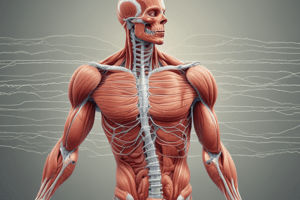Podcast
Questions and Answers
Which type of muscle is responsible for movement in the body?
Which type of muscle is responsible for movement in the body?
- Fibrous
- Skeletal (correct)
- Cardiac
- Smooth
Which type of muscle is responsible for precise movements such as facial expressions and eye movements?
Which type of muscle is responsible for precise movements such as facial expressions and eye movements?
- Skeletal (correct)
- Cardiac
- Fibrous
- Smooth
What is the predominant function of the muscular system?
What is the predominant function of the muscular system?
- Posture
- Joint stability
- Heat production
- Contractility (correct)
What are the three types of muscles in the muscular system?
What are the three types of muscles in the muscular system?
What other important function does muscle contraction perform in the body, besides movement?
What other important function does muscle contraction perform in the body, besides movement?
Match the following types of muscles with their descriptions:
Match the following types of muscles with their descriptions:
Match the following functions of muscle contraction with their descriptions:
Match the following functions of muscle contraction with their descriptions:
Match the following body movements with the types of muscles responsible for them:
Match the following body movements with the types of muscles responsible for them:
Match the following terms with their correct definitions:
Match the following terms with their correct definitions:
Match the following types of movements with their descriptions:
Match the following types of movements with their descriptions:
Flashcards
Skeletal Muscle
Skeletal Muscle
Responsible for movement in the body.
Skeletal Muscle (precise movements)
Skeletal Muscle (precise movements)
Responsible for precise movements such as facial expressions and eye movements.
Contractility
Contractility
The ability to contract and generate force.
Three Types of Muscles
Three Types of Muscles
Signup and view all the flashcards
Study Notes
Muscular System
- The muscular system is responsible for movement in the body.
Types of Muscles
- There are three types of muscles in the muscular system: skeletal, smooth, and cardiac muscle.
Skeletal Muscle
- Responsible for movement in the body, such as walking and running.
- Also responsible for precise movements such as facial expressions and eye movements.
Functions of Muscle Contraction
- Besides movement, muscle contraction also helps with blood circulation and maintaining posture.
Description Matching
- Smooth muscle: involuntary, found in internal organs, and concerned with automatic functions.
- Cardiac muscle: involuntary, found in the heart, and responsible for pumping blood.
- Skeletal muscle: voluntary, found in skeletal muscles, and responsible for movement.
Movement Matching
- Walking and running: skeletal muscle.
- Blood circulation: smooth muscle.
- Pumping blood: cardiac muscle.
Definition Matching
- Muscle tone: a state of partial contraction of muscles that helps maintain posture.
- Isotonic contraction: muscle contraction that produces movement.
- Isometric contraction: muscle contraction that produces tension without movement.
Types of Movements
- Isotonic movement: movement that occurs when muscle contraction produces movement, such as bending the arm.
- Isometric movement: movement that occurs when muscle contraction produces tension without movement, such as holding a weight.
Studying That Suits You
Use AI to generate personalized quizzes and flashcards to suit your learning preferences.




